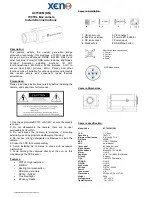
2021-04-13
9
IDS NXT: Setup IDS NXT rio
5 IDS NXT rio
Housing/board-level
+/-
Dimensions height x width x length
34 x 44 x 73 mm
Mechanical specifications
Mechanical specifications
IP code
IP 30
·
Schutz gegen das Eindringen kleiner Fremdkörper
·
Kein Wasserschutz
Ambient conditions
Lens mount
C-mount, see Optical specifications
Mounting holes bottom/top/side/front
4/0/0/0
Thread diameter
M3
Status LED
Interface connector
GigE RJ45, screwable
Power supply
Input I/O connector (M12): 12-24 V DC +20 %, max. 1 A
Input GigE connector (RJ45): PoE 41-57 V DC, max. 350 mA
I/O connector
, screwable
Electrical specifications
5.1 Ambient conditions
The temperature values given below refer to the outer device temperature of the camera housing. The
temperature inside of the camera housing is generally higher than the outer temperature and may be up to
70 °C (158 °F).
Device temperature during operation
0 °C … 55 °C
32 °F … 131 °F
Device temperature during storage
-20 °C … 60 °C
-4 °F … 140 °F
Humidity
20 % … 80 %, relative, non-condensing
Non-condensing means that the relative air humidity must be below 100 %. Otherwise, moisture will form on
the camera surface. If, for example, air has a relative humidity of 40 % at 35 °C (95 °F), the relative humidity
will increase to over 100 % if the air cools down to 19.5 °C (67 °F); condensation begins to form.
CAUTION!
As the camera housing may get hot depending on the operating conditions there
may be risk of burns. Provide sufficient heat dissipation so that the housing temperature does
not exceed 55 °C (131 °F).
Notes on ambient conditions
·
Avoid high air humidity levels and rapid temperature changes when using IDS cameras.
·
Temperatures below +4 °C (39 °F) combined with excessive relative air humidity levels can cause icing.
Provide sufficient heat dissipation so that the specified device temperature is not exceeded during operation.
In general, the following recommendations apply:
·
For a passive heat dissipation, mount the camera on a thermally-conductive surface like a metal plate or a
heat sink.
·
If necessary, provide an active cooling for example by means of a fan.
With increasing device temperatures, the image quality could be reduced due to thermal noise. It is
recommended to mount the camera to a heat-dissipating unit even if the camera is operated below the
maximum specified temperature.










































